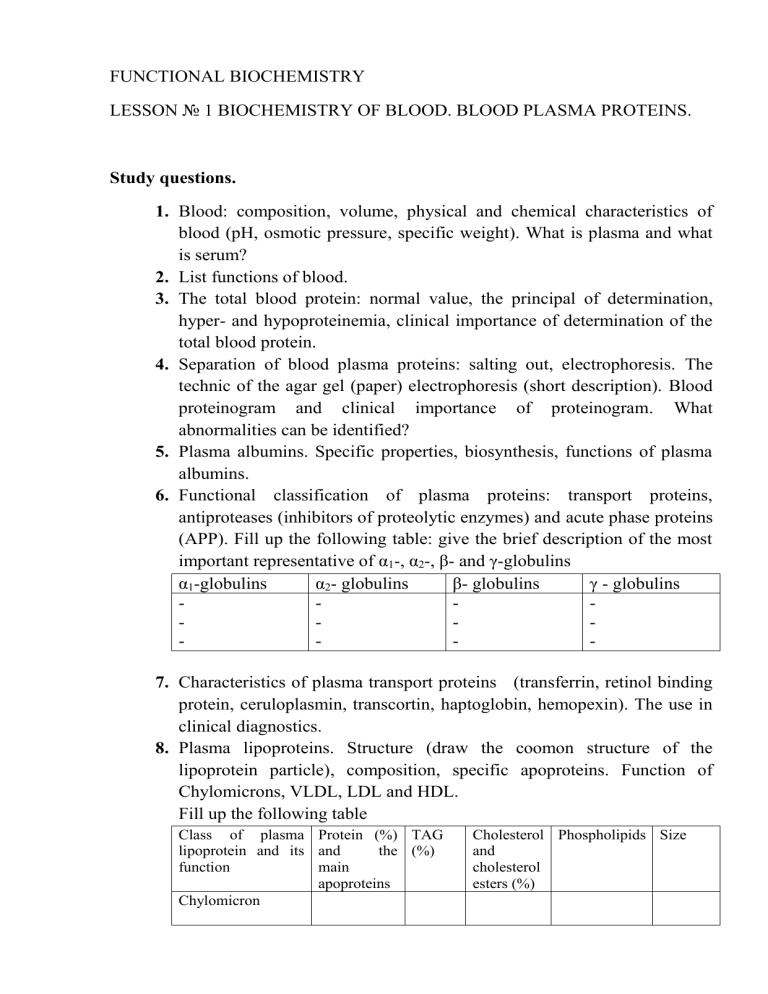
FUNCTIONAL BIOCHEMISTRY LESSON № 1 BIOCHEMISTRY OF BLOOD. BLOOD PLASMA PROTEINS. Study questions. 1. Blood: composition, volume, physical and chemical characteristics of blood (pH, osmotic pressure, specific weight). What is plasma and what is serum? 2. List functions of blood. 3. The total blood protein: normal value, the principal of determination, hyper- and hypoproteinemia, clinical importance of determination of the total blood protein. 4. Separation of blood plasma proteins: salting out, electrophoresis. The technic of the agar gel (paper) electrophoresis (short description). Blood proteinogram and clinical importance of proteinogram. What abnormalities can be identified? 5. Plasma albumins. Specific properties, biosynthesis, functions of plasma albumins. 6. Functional classification of plasma proteins: transport proteins, antiproteases (inhibitors of proteolytic enzymes) and acute phase proteins (APP). Fill up the following table: give the brief description of the most important representative of α1-, α2-, β- and γ-globulins α1-globulins α2- globulins β- globulins γ - globulins 7. Characteristics of plasma transport proteins (transferrin, retinol binding protein, ceruloplasmin, transcortin, haptoglobin, hemopexin). The use in clinical diagnostics. 8. Plasma lipoproteins. Structure (draw the coomon structure of the lipoprotein particle), composition, specific apoproteins. Function of Chylomicrons, VLDL, LDL and HDL. Fill up the following table Class of plasma Protein (%) TAG lipoprotein and its and the (%) function main apoproteins Chylomicron Cholesterol Phospholipids Size and cholesterol esters (%) VLDL LDL HDL 9. Antiproteases: α1-antitrypsin, α2-macroglobulin, α1-antichymotrypsin. 10. Acute phase proteins as a diagnostic tool. Positive and negative acute phase proteins. 11. Blood enzymes : secretory, indicatory and excretory enzymes. 12. Immunoglobulin’s. Structure (draw the common structure of the Ig G) , classes, functions, content on blood). 13. Non-protein components of plasma. Diagnostic importance of their determination. LABORATORY WORK ALBUMIN ASSAY Principle: The assay is based on the selective interaction between albumin and Bromocresol-Green reagent causing the formation of a colored product that is indicated at the wave length 625 nm. Procedure: Place into the tube 0,1 ml of serum (diluted 1:10 with 0,9 % solution of NaCl), 4,0 ml of working reagent, mix the content of the tube. After 10 min incubation read optic density at 625 nm (red light) against working reagent. Perform the same procedure for the calibrator (albumin concentration 50 g per liter). Calculation: C=Dser/Dcalib×50= Normal values: 40-50 g/L Result: Resume:


